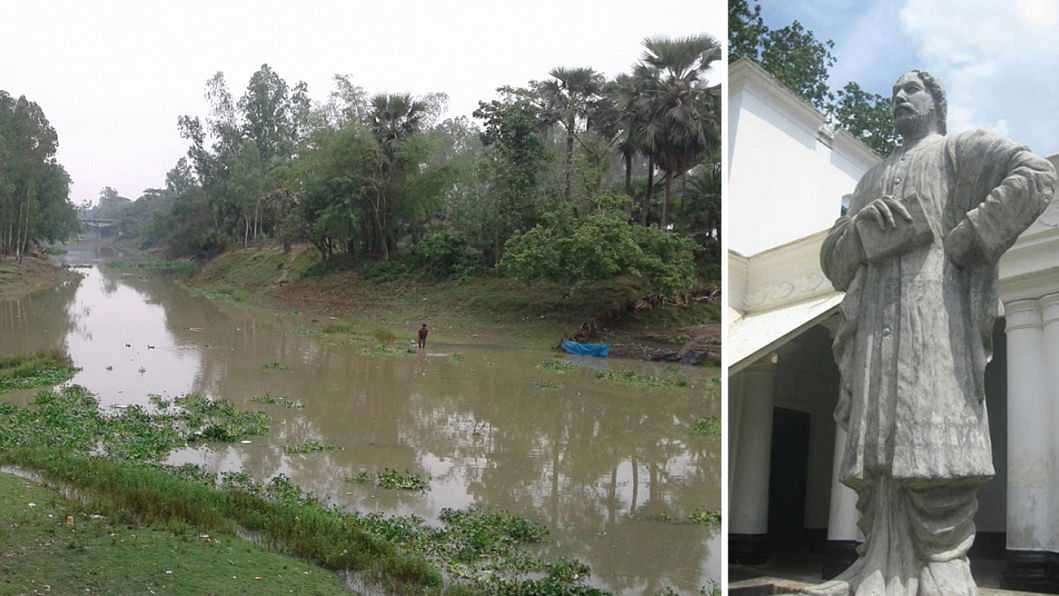Tagore’s memories with Nagor
"I used to sail from Padma to Ichhamoti, from Ichhamoti to Boral, Huro Sagar, Chalan Beel, then Atrai, Nagor River, then after crossing the Jamuna and through Sajadpur canal to Sajadpur."
From Chhinnapatraboli's letters this description is found on how Rabindranath Tagore travelled from Shilaidah to Shahzadpur (Sajadpur) and Patisar. From 1891-1901 he was continuously in Bengal. He used to come in Naogaon's Patisar to observe the estate's condition till 1937. His grandfather Prince Dwarkanath Tagore bought this estate in 1830. Actually to look after that estate Tagore came to Patisar in 1891.
With harvest field widely spread around, the Patisar Kachharibari is situated among the natural greenery. In front, there is an open ground where the people gather every afternoon. There are a few localities around. Local market sits once every week. The natural beauty of Patisar influenced the poetic mind of Rabindranath Tagore. Many of his literary creations were written here. Tagore reflected the realistic lifestyle of the locals of Patisar in his philosophy and literary works.

Alongside many other humanitarian works, Rabindranath made a charitable dispensary for the neglected people of Patisar. Here he spent Taka one lakh and eight thousand from his Nobel Prize money to establish 'Agriculture Bank' for the farmers. He started the use of mechanical plough for the development of agricultural sector. Tagore also formed cooperative organisations for agriculture, knitting and pottery. To educate illiterate local people, he built 'Kaligram Rathindranath Institution' after to the name of his son.
The boat 'Padma' was his favorite company on waterway. There was another small boat too. Tagore was fascinated by the natural beauty around the river Nagor and wrote many illustrious writings. Poet Tagore wrote the famous rhyme 'The palm tree standing on one leg rises high above all and peeks at the sky' sitting on the boat 'Padma'. The palm tree is no more there. But the river Nagor is still flowing near the Patisar Kachharibari. Locals used to call river Nagor as Chhoto Nodi. The poem 'Amader Chhoto Nodi' was also written here in Patisar.
Nagor is still the same as we find it in Tagore's description in the summer season. Still it turns into a shallow water body during the summer month of Baishakh, and looks like a canal having lost its active stream. But, in the rainy season, Nagor is full to the brim. In autumn, catkin blooms by the edge of the river, seemingly playing a game with the clouds.
Nagor, which meets the Chalan Beel from Naogaon via Bogra's Dupchanchia, is becoming narrower over time due to land-grabbing. It has lost its grace for lack of proper maintenance. To keep the memories of Tagore, local authorities should take proper steps for the river to rejuvenate by evicting the illegal properties and stopping sand extraction from it.
Rabindranath also had plans to come to Dupchanchia, where Dupchanchia Model High School is situated on the bank of the river Nagor. It is only 20 kilometers away from Bogra city, which was renowned as Pundrabardhan some 1500 years ago. The school was established towards the end of the 19th century. Some educated and concerned people started the school as a Sanskrit Toll. In 1920, it became an English school, and was named as 'Middle English' (M.E) School. Finally it became Dupchanchia High School in 1923. Anti-colonial activist Ananta Mohon Kundu, a student of this school, got in touch with Rabindranath Tagore. On July 27, 1937, after finishing 'Punhyo' festival at Patisar, Tagore desired to attend a reception ceremony at Dupchanchia High School, but he could not due to sudden physical illness on that day. It was his last day in this Bengal. He conveyed his blessings with a letter.

He wrote, "I wish all the success to Dubchanchia High School in its mission as one of the centres for imparting knowledge in the country."
Many meritorious students passed from this school. Ramendra Kumar Podder was one of them. He was the Vice Chancellor of the University of Calcutta from June 20, 1979 to December 30, 1983.
Tagore's writings at Patisar:
Rabindranath Tagore spent a long time at Patisar. Many of his literary works were written here. Some of them are 'Biday Ovishap', poetry 'Chitra', novel 'Gora', some parts of 'Ghore Baire', short story 'Protihingsa', 'Thakurda', and article 'Engrej O Bhartabasi'. Notable songs written here include 'Tumi sandhyar meghmala', 'Tumi amar nivrito sadhana', 'Bodhu miche rag korona', 'Tumi noborupe eso prane'. He wrote 54 poems of his renowned poetry collection 'Chaitali' here. The famous poems 'Dui bigha jomi' and 'Sandhya' were also written here.
Our little river
Our little river flows in graceful loops
The summer heat dries her to a gentle flow,
Both cart and cattle travel across with ease
Her banks are high, her depths are shallow
The sand bed glitters, no trace of mud
The far bank shimmers with Kash flowers white,
where flocks of mynas chirp busily all day
And jackal calls arise at night
This bank shelters sleepy hamlets in the shade
of ranks of ancient mango and palm tree
At bath times, children swim and play
Splashing water at each other in noisy glee
Each day as their bathing is done
They catch little fish in nets of cloth
Women take home their pots scrubbed clean
Their washing all done, they return to their chores
When the rains descend, the river swells fast
Rushing waters raise voice in happy uproar,
The muddy torrent spins in eddies and swirls
Both banks uniting in joyous clamor
Awake, to join in the festival of rain.
Poem Source: Our little river

 For all latest news, follow The Daily Star's Google News channel.
For all latest news, follow The Daily Star's Google News channel. 



Comments